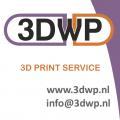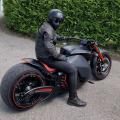Results 1 to 10 of 21
Thread: Tests, advices and tips
-
07-24-2015, 06:08 AM #1Student

- Join Date
- Jul 2015
- Posts
- 9
Tests, advices and tips
Hey Guys!
I will tell you some of my experiences, tests, and tricks that I am applying for scanning.I took two weeks conducting scans of different types of models of different sizes, and I will share my experiences.
To begin, I use the tripod for free scanning and standard mode scanning with turntable. Is very flexible, and doing a few tests, you can scan objects of respectable sizes, using the automatic mode.
The light is very important. If the room has plenty of natural light, the calibrations will not work, or will scans misaligned.
One of my first models was a dragon with a broken claw.
dragon.jpg
The figure is complex and has dark colored varieties. I added three standard scans at different angles. To scan areas in shadow, I made 3dprintings pieces that help me support models at different angles (wedges and supports) .The result is surprising and very fast compared with other scanners (Matter & Form). Add other examples of scans, such as the figure of a virgin, which exceeds scan size "standard", but to use the tripod, I got a range that was able to catch all the model, and it was automatic . The figure was matte white. The result is spectacular.
virgen.jpg
After these examples, I scanned a lion marble protruding from the turntable, but add 4 scans, not only with different angles, but also with protruding parts of the turntable drive. The result was excellent, but with some noise caused by the material, so I had to do some retouching in Zbrush.
leon large.jpg
The hardest to scan parts are metals and dark colors. Even materials that do not seem problematic, as had the lion, can cause noise and loss of details.For avoid this, users are using talc to solve the problems, but in metals talc is not permanent, it is not fixed. To create a coat of matte white, I tested the liquid vinyl, and it works great! The liquid vinyl is used to paint plastic parts for cars, or thumbnails, and the biggest advantage is that ... removes easily with your fingers. For this to be done, you have to give at least two or three coats of paint as if it only gives the layer is very thin and breaks when removed, and is much more work. The layers are very thin, and no detail is lost. I performed two tests, one with the lion..and the result is very soft, and recovers details in the mane.
vinyl.jpg
Finally, I attached a base of a collectible figure, which I painted with vinyl and is relatively large ... the same size as the turntable. Only I applied a layer of vinyl only, so separate it is becoming more difficult ... with a thicker layer would have been better to remove.
Regardless, this layer is sufficient to achieve high detail in scanning, detecting very fine grooves on the base. Besides ... this scan was performed in free mode. Only 3 scans were sufficient to achieve the end result, then retouched in Zbrush.
alienbase.jpg
I hope my advice and my experience will serve to enhance your scans, and encourage Shinig3d to improve the software, as there is much room for improvement, as the Cancel button, point cloud export ... and .. ¿Colour? : D: D
Keep in touch!
-
07-31-2015, 09:39 AM #2
Nice pictures and tips, thanks! I hope to test mu scanner soon, did anybody hear if batch 3 is underway?
I see you use Zbrush, I now use MeshMixer and can recommend it to people to use for editing mesh files.
-
08-11-2015, 03:56 AM #3Student

- Join Date
- Jun 2015
- Posts
- 7
good tips.
-
08-11-2015, 05:19 AM #4
Thank you so much for your tips! We will work hard.
-
08-14-2015, 01:25 PM #5Student

- Join Date
- Aug 2015
- Location
- Atlanta, GA, USA
- Posts
- 3
Environment
This was a major breakthrough for me! I was about to pitch the whole thing in the garbage, scanning was so frustrating... Turned off my lights in the office and closed the blinds, now all of a sudden scans come out actually aligned and the software does not crash (as often).
Still trying to figure out how to add additional scans on the turn table. If I take my model and continue the scanning with another round but taking the figurine (for instance) and laying it flat, it will come out merged. if only the software would remove the scanning table from the mesh, I think it would actually resolve. Any ideas there and how did you add more scans to your project?
-
08-14-2015, 08:29 PM #6
Wow! You sure do get discouraged quickly!
If you get a few minutes, you should read through all the threads on this forum, I think you will find that this scanner is very capable of doing more than the Shining3D says, not less. (Which is surprising in the 3D scanning world)
Free scan mode is where it is at with this scanner, with a properly setup "lazy susan" bearing you can turn the model yourself at any angle you want and take as many scans as you want, as long as that winds up being less than 200, unless you have an amazing computer.
I cannot imagine a model that would be best suited to the automatic turn table. Maybe a baseball? The turntable is great for calibration, then I put it away.
The is the back of a transmission I scanned a couple days ago, by tweaking my approach I was able to scan the entire transmission in a single session. Now if only we could save as we were scanning...
012_Rear2.jpg
Dave @ Nerv
-
08-15-2015, 09:33 AM #7Student

- Join Date
- Jul 2015
- Posts
- 29
hey guys,please remeber the scanner is optical device, so the light will obviously affect the scanning.and there is a preview window on the left under the turntable mode and calibrating mode.with tripod mode, there will be two there.you should look at it before you do anything, please.thank you.
-
08-16-2015, 02:10 AM #8
-
08-16-2015, 10:17 AM #9
That is a great scan Dave, I was going to drive a lazy susan using the existing turntable, by adapting it. Now after seeing this scan I probably won't bother.
That's exactly what I want to do, and all that remains is to get it into CAD.
What size was that scan Dave?...I just did a small torsion bar tube for one of my engines, and it ended up being 66MB as a STL file.
-
08-16-2015, 11:49 AM #10
Thanks for the feedback guys.
That scan, 1.2 GB. A properly setup quadric edge collapse decimation algorithm can knock it down to 1/10 with no visible difference.
This is another scan, the entire transmission in one session: I've seen lower quality scans of transmissions with scanners worth 50x as much as this scanner!
It does take a very specific set of tricks to scan large items like this without any alignment problems and no crashing. Getting to this point has taken a ton of work.
Any surface deviation is actual casting flaws, not scanning data issues.
If you have tried scanning fins with the Einscan-S, you can appreciate this scan that much more
012_Trans2.jpg




 Reply With Quote
Reply With Quote











Extruder not feeding during print,...
Yesterday, 01:59 AM in Tips, Tricks and Tech Help